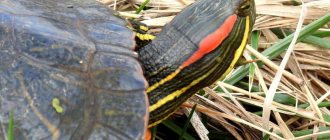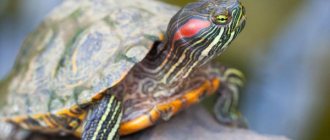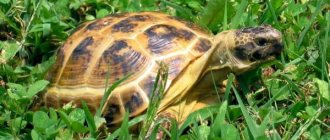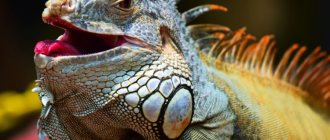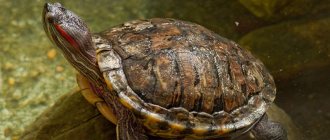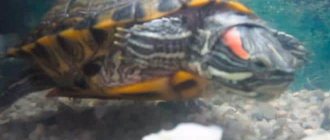Review author: “ZooVita”
All turtles, according to their way of life, are divided into two large groups: land and aquatic inhabitants. At home, you can only find representatives of the second group, because today there are very few land reptiles left (declining population numbers).
Photos of various representatives of aquatic turtles will allow you to familiarize yourself with the features of the external structure and habitat.
Main types of aquatic turtles
Three groups are recognized as the most popular species of domestic aquatic turtles:
- Pond slider.
- Chinese Trionics.
- Swamp turtle.
For each variety there are a number of characteristic external features by which reptiles can be distinguished from each other.
Nutritional conditions of adults
When keeping a red-eared slider at home, you should know that they feed in water. That is, the food will have to be poured directly into the aquarium. Monitor what she has eaten and remove any leftover food. Some breeders organize a special separate container for this purpose. The pet is fed in it, waits for a bowel movement, and is transferred back. At this moment it is very convenient to immediately take care of the owner of the aquarium.
Adults happily eat bloodworms, squid, and meat. You can give thawed frozen fish along with bones - this will solve the problem of calcium deficiency. Perch fish, if it is large enough, should be disassembled and the rib part of the bones removed, and the spine simply cut. Fish bones are a must in the diet. Shrimp are an excellent way out, since reptiles need chitin, which is contained in large quantities in the shell of shrimp. Also, your pet can be treated to special crustaceans, and you should not be afraid of their hard house.
Raw liver should be given once a week; if your pet enjoys eating it, you need to reduce the dose of vitamins. This point, as well as the question of the amount of vitamins required for your pet, should be discussed with your veterinarian.
It is also necessary to include plant foods in the diet, this could be fresh cabbage, spinach, and greens. The main thing is to wash the plants thoroughly.
You can tell that a turtle is hungry by its behavior. A hungry turtle rummages through the rocks, actively explores the corners of the aquarium, and behaves restlessly compared to its usual state, at a time of day when it would usually be asleep.
Pond slider
It is an inhabitant of freshwater bodies of water. The habitat includes wetlands of North America, Europe, and several Asian countries. External features include the following:
- The shell is painted a rich green color. But the lower part of the stratum corneum is presented in yellow tones with an original pattern. Interesting rings (specific pattern) are scattered across the surface of the entire carapace.
- The skin of the head, limbs, and neck is brightly colored in the form of alternating yellow stripes.
- Distinctive features are red spots on the head, for which turtles got their name. As the reptile matures, the coloring loses its intensity.
- Freshwater turtles can freely hide their head and limbs under their shell, because the size of their head allows this to be done.
- The shape of the shell may vary. In sea dwellers, the horny shield takes on a teardrop shape; freshwater and domestic turtles have a flat shell.
Like all aquatic reptiles, this subspecies has no teeth. Their role is played by rows of horny ridges. And sufficiently developed chewing muscles allow turtles to remain active predators and firmly hold snails, worms and other small animals.
Keeping domestic aquatic turtles of this subspecies does not require special skills and knowledge, because the representatives are quite unpretentious in care.
How to treat an animal?
If this is your first time getting such a pet, don’t get lost. There is nothing difficult about caring for red-eared turtles at home. You just need to know what they are capable of and how they perceive our world. These four-legged animals have well-developed vision and sense of smell (turtles distinguish colors, detect other people's motor activity at a distance of up to 40 meters, and look for food by smell). But they hear poorly: after all, their ears are covered with skin. Only vibration and dull sounds are available to them. The shell is not just armor and protection, it is a part of the body that is very sensitive to touch because many nerves pass through it. Taste buds are also well developed: pets can refuse tasteless food in favor of some favorite treat.
The animals themselves make a variety of sounds: squeaks, snorts and hisses. Do not forget that turtles cannot breathe underwater; to breathe, they must rise to the surface. In general, these are very sensitive creatures that require special care. Organizing it is not at all difficult, the main thing is to follow the recommendations correctly.
As soon as you have a pet, get ready for a pleasant acquaintance, try to get to know your red-eared friend (or friend) better. Read the article: How to determine the sex of a turtle! Show it to the veterinarian: you won’t be able to make sure on your own that the new family member hasn’t brought a bunch of turtle diseases. If you already have turtles living in your house, don’t rush to add a new one to them. Arrange a kind of quarantine for her for 2-3 months (during this period you can make sure that the red-eared one is healthy).
Never place young turtles with old ones: “hazing” is rampant among these creatures, and often the “seasoned” inhabitants of the terrarium cripple the young ones.
Your pet needs time to adapt to an unfamiliar environment. During this difficult period, try not to bother him with your attention, do not pick him up.
Chinese Trionix
One of the few representatives of soft-bodied turtles. The shell does not have hard horny plates on the surface, and consists only of thick but soft skin.
The characteristic features of the structure include the following:
- The leathery shell is completely covered with small tubercles, by which experts can track the age of the reptile.
- The traditional color is represented by green-brown colors and a yellow border along the lower edge of the shell.
- In addition to all external features, the turtle is distinguished by its relatively small size. The weight of an adult rarely exceeds 4 kg.
- Very sharp horny ridges that completely replace teeth in reptiles.
- The structural features of the shell provided the Chinese turtle with a unique opportunity - full skin respiration. A sufficiently developed blood network under the skin allows the animal to stay under water for up to 15 hours.
- Very fast reaction to signs of danger and to the appearance of food in the visibility zone.
Thanks to their soft shell, reptiles easily burrow into the ground. This property should be remembered when organizing an aquarium with this variety of turtles.
About little red-eared turtles
Almost all future owners of turtles want to get them when they are still small - cute, touching and funny. But raising such a baby to the average size of a one-year-old is not easy: the mortality rate in babies is very high. And most often - due to improper handling of them.
So what not to do?
- Remove the yolk sac on the plastron from small animals yourself.
- Create stressful situations.
- Take the extra one at a time.
Living conditions need to be made as comfortable as possible. What to feed baby red-eared turtles? Exclusively food of animal origin: 70% small lean fish and 30% by-products, insects, squid, shrimp, etc.
A terrarium for a red-eared turtle of any age should be placed so that it is not exposed to direct sunlight or drafts. But unlike adults, babies need a different temperature regime: water - 26-27 degrees, land - 32 degrees.
Swamp turtle
The small and compact marsh turtle very often becomes an inhabitant of home terrariums or aquariums. It has a durable shell consisting of horny scutes. The color is traditionally marsh color (the shade can vary greatly), gradually darkening with age.
A characteristic feature of the marsh turtle is its eyes, which can have a red, orange or amber tint. There is no beak, the jaw apparatus is quite developed.
Reptiles of this subspecies are more agile than other representatives of aquatic turtles. On land, to lay eggs, it can travel considerable distances from water (for example, up to 8 km).
Health and illness
Animal health is 90% determined by compliance with the rules for the care, nutrition and maintenance of turtles in a home aquarium.
Tips for keeping your animal healthy:
- for sick turtles, the temperature is raised to 27–30 degrees (for immunity);
- maintain fluid balance, avoid dehydration (the turtle should be in water, drinking);
- for a sick animal, reduce the water level in the aquarium so that it does not drown (if the turtle is a poor swimmer, it should be able to freely go ashore);
- If you suspect an infection, isolate the animal and wash your hands after contact;
- do not self-medicate, seek help from a veterinarian-herpetologist.
Hibernation
In nature, hibernation is a reaction to unfavorable environmental conditions, cold and heat. Such sleep for animals helps to survive these periods.
At home, where they are comfortable, there is no need to hibernate. Don't stimulate hibernation!
Walks
Take turtles outdoors so they get natural sunlight. Take it out into the courtyard of a house in the city, take it with you to your summer cottage.
For a walk, try to choose dry, sunny, windless, warm weather. At temperatures below 25 degrees and in other weather conditions, it is better to keep the animal at home.
Take your pet to a clean, quiet area with some shade and vegetation. She will happily eat fresh clover, plantain, and dandelion.
At your dacha, build a special pen for walking for a land turtle, and a private pool for an aquatic turtle.
When walking, provide constant supervision to the animal so that it does not eat anything harmful, does not get hurt, or runs away. Protect it from insects, animals, birds, children, from overheating and cooling.
When you get home, check your pet for any wounds or contamination. If they are very dirty, wash them.
Feeding features of aquatic turtles
The diet of aquatic reptiles is varied and has an approximately equal ratio of plant and animal foods. How to feed aquatic turtles:
- In zoological stores you can buy ready-made food for your pets, which contains all the necessary ingredients balanced.
- For variety, you can feed your pet turtles worms, insects, shrimp, or small fish. Various vegetable mixtures are excellent as a source of fiber and vitamins.
- Be sure to periodically introduce vitamin D and calcium into the diet, which are necessary for healthy shell growth.
In the wild, turtles feed on small insects, flies, dragonflies, frogs and even small fish.
The plant component is marsh grass, algae, and plant leaves. On land, these types of reptiles cannot feed because they need water to swallow food.
Appearance
A turtle at home is exotic, and its appearance is also unusual.
Animal body:
- head and eyes;
- neck;
- beak and tongue;
- shell;
- color;
- limbs;
- tail;
- dimensions.
The head of these reptiles is streamlined and designed in such a way that the animal can quickly pull it under its shell. In some species, the length of the neck is equal to the length of the shell.
These animals have a strong and hard beak with bulges inside, with sharp or jagged edges that act as teeth.
The function of the shell is protection. The dorsal (upper) part is called the carapace, the ventral (lower) part is called the plastron.
The size of a turtle is measured by the length of its shell. Determine the length using a ruler despite the fact that the surface of the dorsal part is uneven.
They grow slowly throughout life. In adult individuals, the length of the carapace is 20–30 cm.
The tail is hidden inside the shell. The tip of the tail in some species is pointed, similar to a spike.
Differences between Central Asian and red-eared cats in appearance
| Appearance | Central Asian | red-eared |
| Color | Yellow-beige color, shapeless dark spots on the shell. | The carapace has characteristic stripes of olive, black, and yellow colors. |
| Plastron | Dark color. | Smooth, variegated color: dark spots on a yellow background. |
| Head | The upper jaw is hooked. | From the eyes to the neck, on both sides there are yellow-red lines resembling ears. |
| Eyes | Located on the sides of the head in such a way that they look down; small, black. | Directed forward and upward, located near the crown. |
| Limbs | The front paws are flat, designed to dig soil, and the hind paws are powerful and strong. They have four toes on their front paws with blunt claws. | The feet have leathery membranes for swimming. |
| Dimensions | Cubs are born 3–3.4 cm long and weigh 10–12 grams. By the second year of life, the size will increase to 5 cm, by the fourth to 9 cm. The weight of an adult turtle grows to 2 kg. | A newborn cub is 2.4 cm long, and during the first year of life it gains 2.5–4.5 cm. At two years, its size will be 8 cm, at six years - 18 cm. |
Sense organs
Turtles have good low-frequency hearing and excellent color vision.
Red-eared turtles have an excellent sense of smell and smell. They see both in water and above water. Hearing is like that of cats: they can distinguish dull sounds and vibrations. Nerve endings pass through the shell. Animals with a sense of touch distinguish the taste of food.
Aquatic turtles are not adapted to breathe underwater; they swim up for oxygen.
Lifespan
The average lifespan of these animals in their natural environment is 20–30 years. If kept at home, if the rules of care are followed, pets will live up to 40-50 years.
In captivity, these reptiles grow faster as they receive high-quality nutrition and a comfortable life.
When determining age, they are guided by size and also count the number of rings on the shell. In one year, 2–3 rings are formed. But this growth is not uniform; it is influenced by conditions of detention, illness, and hibernation.
In older individuals, the carapace is smooth, the growth rings are pale. The younger the turtle, the brighter its color.
Inappropriate maintenance and disease are the main causes of death.
In another article, we took a closer look at how long turtles live.
Keeping at home
Aquatic turtles quite often become pets, mainly due to their slow metabolism, relative ease of care and original appearance.
Helpful tips on how to care for an aquatic turtle:
- First of all, you will need to purchase an aquarium of sufficient volume (approximately 150-200 liters).
- The aquarium must provide a dry place where the reptile will spend some period of time.
- In an aquatic environment, it is necessary to maintain the temperature at the same level, which is 28 degrees. At night, the temperature can be lowered to 23 degrees.
- An ultraviolet lamp is installed near the dry area (maintains a temperature of 32-36 degrees to warm the pet).
- The temperature is controlled using a thermometer.
- To maintain water purity at the proper level, you need a filter that must be changed periodically.
- The water is changed 2-3 times a month or as it gets dirty. Before filling the aquarium, the water is allowed to settle for 24 hours.
Careful adherence to the regime and proper nutrition will help increase the life of your pet.
Should you pick up a turtle?
Let us remind you that red-eared turtles live at home in an aquarium . When removing an animal from the water, be prepared for it to be slippery. But this is not the main difficulty. The yellow-bellied creature is 100% likely to resist such contact. The turtle will begin to hiss, scratch you with powerful paws with sharp claws, bite, and it is possible that he will attempt to empty his bowels directly into your palm.
So in theory, you can pick up your pet, but is there a need for this tactile contact? If touching cannot be avoided, take the animal with both hands, fix it carefully but firmly, then the turtle will not slip out and you will not be bitten.
After contact, be sure to wash your hands with soap. Make sure that children do this especially. Explain to kids that affection with red-eared cats is unacceptable: these creatures, cute at first glance, can be dangerous, because carry salmonellosis. For this reason, animals should not wander around the kitchen and, especially, the dining table. You should also avoid washing your pet or its aquarium and accessories in the kitchen sink or bathtub.
Photos of aquatic turtles
Content Features
The red-eared turtle is quite demanding in terms of living conditions. When purchasing such a pet, you need to understand that the size of the aquarium does not have any effect on the size of the reptile. Even in a small container the animal will grow, but will become weak and sick.
To provide your reptile with comfortable living conditions, you must purchase the following:
- aquarium for turtles with a volume of 150 l;
- 100 Watt water heater;
- external filter;
- ultraviolet lamp for aquatic turtles with UVB 10%;
- heating lamp;
- lighting lamp;
- thermometer;
- sushi element.
In addition to all of the above, you should choose a strong table or cabinet, since the weight of all the equipment is quite high.
The aquarium consists of a number of elements
Proper care
At home, the red-eared turtle needs to equip an aquaterrarium - an aquarium with a land island. Such an island will allow your pet to crawl out of the water and bask under the lamp. You can purchase it at a specialty store or make it yourself.
When choosing land, you need to take into account the surface size of the aquarium. The shore should occupy at least a quarter of it. It is also necessary that the island meet certain requirements:
- Heating. The air temperature on land should be 10 °C higher than the water temperature.
- Half-flooded. At least one side of the island should go into the water so that the reptile can easily get onto land.
- Safety. There should be such a distance between the walls of the aquaterrarium and the shore so that the animal does not get stuck. The materials from which the island is made should not emit toxic substances when heated and in contact with water.
- Sustainability. The turtle has strong paws, and therefore, when climbing onto the island, it can turn it over.
- Texture. To prevent an animal from slipping on land, the surface of the shore must be textured.
Soil, like decor, is optional in an aquaterrarium. If you still want to add decorativeness, then it is better to use large stones. Small decorative elements can be swallowed by reptiles. But you need to take into account that the soil makes cleaning the aquarium difficult.
Heating and ultraviolet
Since the turtle is a cold-blooded creature, it needs to bask in the sun. Such a warm shore needs to be provided to the animal in a home aquaterrarium. To achieve a suitable temperature of 30-35°C, the lamp should be placed directly above the pet. At the same time, the owner should regularly check the temperature so that the reptile does not get burned.
Don't forget about ultraviolet light
In the wild, natural light and warmth allow the turtle's body to produce substances necessary for normal functioning. But if it lives in captivity, then the owner will have to provide the reptile with a sufficient amount of ultraviolet light, which helps the proper absorption of calcium and the production of B vitamins. The absence of such a lamp in the aquaterrarium leads to the fact that the reptile’s shell develops poorly. In addition, the animal may become seriously ill.
Both lamps should work every day from 10 to 12 hours, and the ultraviolet lamp should be placed directly above the pet’s bed so that glass and plastic do not interfere with the passage of the rays.
Water environment
The red-eared slider is an aquatic reptile and spends most of its life in water. In order for an animal to feel good in an aquaterrarium, it must have a sufficient amount of clean water.
The minimum water level is considered to be one at which the pet can turn over freely, that is, it must be no less than the width of the animal’s shell. But it will be good if it is possible to maintain it at a higher level - the reptile will be able to swim, and the water will remain clean longer. It should be remembered that at any water level the reptile must be able to get to land for heating.
Before pouring liquid into the aquarium, it must be left for at least a day . This will allow the water to warm up and remove chlorine. In the aquaterrarium itself, the temperature of the aquatic environment should remain between 22 and 28 °C, it should be checked using a thermometer. To maintain the optimal temperature, you need to use a heater.
Another important parameter is water purity. Keeping the water environment clean is very important, although it is not easy to do. The turtle eats and defecates in water, so various harmful substances quickly accumulate in it. To avoid this, change the water weekly. In addition, it is necessary to use special filters. Dirty water will not only spoil the decorative appearance of the aquaterrarium, but can also cause illness and even death of the animal.
A number of requirements for the aquatic environment
Turtle diet
This reptile is omnivorous. A variety of foods helps keep your pet healthy. For feeding you can use:
- specialized food for aquatic turtles;
- food for aquarium fish;
- insects;
- vegetables;
- fish;
- aquarium plants;
- invertebrates.
It is important to make a balanced diet by including foods high in calcium. But you need to take into account that the reptile tends to overeat.
Despite the pet’s omnivorous nature, experts advise giving preference to specialized food for American turtles. There are quite a lot of them, which allows you to choose the best option for a particular animal. The undoubted advantage of such foods is that they contain all the nutrients necessary for reptiles. In addition, the high protein content allows the turtle to be satisfied in smaller portions.
This animal does not produce saliva, so it needs water to swallow food. She can take food on land, but she will still eat it in the water. To keep the water in the aquaterrarium clean longer, the reptile can be fed in a separate container.
The frequency of feedings varies depending on the age of the animal and the type of food. The young turtle is fed every day with ready-made food. In addition, she should be offered plant food daily, even if she does not want to eat it. A pet older than a year is fed less often, about every other day or two. If the food is plant-based, then you can use it more often.
Water is an integral part of the diet
The amount of food given to the reptile also differs. Animals that have recently hatched need food with 50% protein. Most foods contain approximately 40% of this substance, and therefore they can be given complementary food in the form of small aquarium fish, insects and earthworms. When feeding adults, artificial feed should be much less - from 10 to 25%. The rest of the food in this case comes from plants.
To provide your animal with good food and not overfeed, you should always read the instructions on the packaging. We should not forget that feeds can differ significantly from each other.
Such different reptiles
In nature, there are many varieties of these reptiles. The most famous species of sea turtles are:
- The leatherback turtle is the largest sea turtle. The span of the front flippers of a leatherback turtle reaches three meters; the size of the shell is approximately the same. Weight can reach 900 kg. The leatherback turtle received this name because of the surface of the carapace, which is covered with dense skin. The giant sea turtle is considered the oldest. American authorities have created a national park on the habitat of leatherback turtles;
- Green sea turtle (or soup turtle) . The length of her body reaches 1.5 meters. The weight is much less than that of the leatherback turtle and does not exceed 250 kg. The dimensions of the shell range from 80 to 120 cm. The color is different - it can be either light green or dark brown, but always with white spots and stripes. The carapace is oval, small in height, covered with large horny scutes. Delicacies are prepared from the meat of this turtle;
- Hawksbill turtle - similar to a green reptile, but slightly smaller - body length about 80 cm. Weight - 40-50 kg. The carapace is heart-shaped, brown with yellow spots, covered with thick horny scutes. Its posterior part is narrowed and sharpened. A distinctive feature is a strong horny beak.
Reproduction
Reptile lovers prefer to breed small turtles, but this procedure requires certain knowledge and skills. In captivity, aquatic turtles are not sexually active, so it will not be easy to get offspring from your pets. Reptiles do not organize mating games on their own and will not begin to reproduce.
The main condition is that both individuals must be at sexually mature age, but not too old. Turtles that are ready to breed should be placed in a separate aquarium with all the conditions for comfortable keeping. The mating process is not related to the season, so mating games can begin even in winter.
The average clutch of eggs of a female is from 5 to 10 pieces; the owner must provide a special place for their placement. It is important not to leave the eggs in the exact container where they were laid by the turtle, but to carefully transfer them to the place where the incubator is planned.
The average development period for small turtles is from 2 to 5 months, after which the hatching process occurs. It is important to maintain a comfortable temperature all this time - 25-30 degrees. After the hatchlings are born, it is important to separate them from other individuals, since adult turtles lack maternal instinct.
Habitat of red-eared turtles
Trachemys scripta's habitat is primarily southeastern America and the adjacent region of Mexico: from southwestern Virginia through Florida, Alabama, Mississippi, Louisiana and Texas to Mexico. To the north, the habitat extends to the ends of Kentucky, Tennessee, Ohio, Indiana, Illinois and Iowa, and to the west to Kansas, Oklahoma and New Mexico.
Red-eared slider sizes
Trachemys scripta elegans predominates predominantly in the western and central parts of this range. Occupying the Mississippi Valley from Illinois through eastern New Mexico west to the Gulf of Mexico.
Trachemys scripta scripta is predominant in the eastern part of its previously described range, ranging from southeastern Virginia to northern Florida. It should be noted here that an intergradation zone of Ts elegans and Ts scripta is formed in Alabama.
Trachemys scripta troostii has the smallest range of occurrence and is found in the upper Cumberland and Tennessee rivers. From southeastern Kentucky and southwestern Virginia through Tennessee to northeastern Alabama.
Trachemys scripta occurs in a wide range of freshwater habitats including rivers, ditches, swamps, lakes and ponds. Quiet reservoirs with a soft bottom and an abundance of aquatic vegetation.
Life of reptiles in the wild
Sea turtles live in the Indian and Pacific Oceans. There are reptiles in the Atlantic. They spend their entire lives in the water, coming ashore only to lay eggs. On land, reptiles are extremely slow, but in the sea they are tireless swimmers.
What do sea creatures eat? Small turtles prefer to feast on zooplankton and small nekton, while large individuals love plant foods, but will not refuse small sea inhabitants.
In one year of nesting, the female makes more than five clutches, in each of which the number of eggs can reach up to 200 eggs. Having laid eggs, the turtle swims away - it does not return to the place of laying.
FACT! The sex of the future turtle depends on the conditions and temperature. When the weather is warm, females appear; when it gets cold, males appear.
The development of future turtles in the egg lasts two months. If temperature changes occurred during this period, the masonry may completely die.
The hatchlings are removed from the shell using an egg tooth. Once hatched, they immediately become potential food for sea, land and air predators. Few manage to survive.
